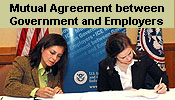
Search
Info Updates
National Threat Advisory
Elevated
![]()
Significant Risk of Terrorist Attacks
Report Suspicious Activity:
1-866-DHS-2-ICE1-866-347-2423
Information for families of ICE detainees:
Contact InformationInternational Students
September 1, 2004
FACT SHEET
I-901 SEVIS FEE: Payment Options for Exchange Visitors and Exchange Visitors Program Sponsors
Beginning September 1, 2004, the Department of Homeland Security (DHS) will collect a congressionally mandated fee to cover the costs for the continued operation of the Student and Exchange Visitor Program (SEVP). This fee will be used to administer and maintain the Student and Exchange Visitor Information System (SEVIS), support compliance activities, and establish SEVIS Liaison Officers to provide information and assistance to students and schools.
Some schools or programs charge a fee by the year or the semester to support their foreign student/exchange visitor office and automated systems. These fees are neither mandated nor collected by the U.S. government.
The payment of I-901 fees will be recorded and tracked in SEVIS, the automated system for collecting, maintaining, and managing information about nonimmigrant student and exchange visitors in the United States.
Who pays the fee?
Those who seek admission to the United States as an exchange visitor with a DS-2019 dated on or after September 1, 2004. Participants of federally sponsored exchange visitor programs, which are designated by program codes beginning with G-1, G-2, or G-3, are not subject to this fee. Spouses and dependent children of exchange visitors (J-2) do not pay this fee.
How much is the fee?
|
For spouses and dependent children (J-2) exchange visitors |
None |
For exchange visitors (J-1) except those listed separately below | $100 |
For exchange visitor programs participating in a federally sponsored program (program codes that start with G-1, G-2, or G-3) |
None |
|
Summer work/travel program |
$35 |
|
Au Pair program |
$35 |
Camp counselor program |
$35 |
When do prospective exchange visitors pay the SEVIS fee?
- Applicants who require a visa to enter the United States must pay the SEVIS fee before going to the U.S. embassy or consulate for their visa interviews.
- Applicants who are citizens of Canada, Bermuda, the Bahamas, or certain other islands described in 8 CFR 212.1(a) wishing to apply for J-1 status at a Port of Entry into the United States must pay the SEVIS fee before entering the country.
- Nonimmigrants currently in the United States who apply for exchange visitor status must pay the fee prior to filing their change of status application./li>
When must the fee be paid?
The fee must be paid prior to the visa interview to ensure that the payment can be deposited and recorded in SEVIS prior to the scheduled visa interview. The interviewing consular officer will confirm that the fee has been paid by accessing SEVIS. To allow for adequate processing time the fee must be paid:
- At least three business days prior to the visa interview date for electronic submissions.
- For regular mail submissions, 15 business days should be allowed before the scheduled visa interview. This time frame allows adequate time for the fee payment to be received at the DHS address listed on the Form I-901, deposited, and recorded in SEVIS.
- Add local mail processing times to these processing times for accuracy.
How can the fee be paid?
The Exchange Visitor may pay the fee:
- Through the Internet at www.FMJfee.com by using a credit card or debit card and completing the online Form I-901 (Fee for Remittance for Certain F, M, and J Nonimmigrant); or
- Through the mail by submitting a completed Form I-901 and a check or money order drawn on a U.S. bank and payable in U.S. currency.
Are there other payment options?
A program sponsor or other third party may elect to pay the fee by:
- Completing a paper Form I-901 and forwarding it to the exchange visitor with the request to mail it in with the payment; or
- Completing paper Form(s) I-901 for a group of exchange visitors and sending them in with one check that covers the payment for all the submitted forms; or
- Completing an electronic version of the Form I-901 online on behalf of the exchange visitor(s), printing out the payment coupon(s), and sending it to the exchange visitor(s) for submission with the fee; or
- Completing an electronic version of the Form I-901 on the Internet, using a sponsor-owned credit card to pay the fee, printing out the form I-797 receipt and sending it to the exchange visitor along with the DS-2019.
- Bulk filing allows sponsors to electronically transmit a file or Form I-901 data to the I-901 Fee Collection system and electronically pay the fee for the entire batch via a single ACD Debit. (See the fact sheet on the Bulk Filer program for additional information and requirements).
How will the payment be verified?
The payment will be recorded in the SEVIS system. However, it is recommended that the exchange visitor hand-carry a paper I-797 or the Internet-generated receipt to the visa interview and for arrival at the Port of Entry.
- DHS will issue an official paper receipt (I-797) for every payment received.
- Individuals may request Express delivery service for the I-797 receipt at an additional cost of $30.
- Individuals who file electronically will be able to print an electronic receipt immediately at the time of payment.
When must continuing exchange visitors (J-1 nonimmigrant who have begun but not finished a program) pay the SEVIS fee?
Continuing exchange visitors must pay the SEVIS fee before:
- Filing a reinstatement application after a substantive violation; or
- Filing a reinstatement application after they have been out of status between 121 and 269 days; or
- Applying for a change of exchange visitor category, unless the new exchange visitor category is fee exempt (federally sponsored programs with program codes that start with G-1, G-2, or G-3).
# ICE #






